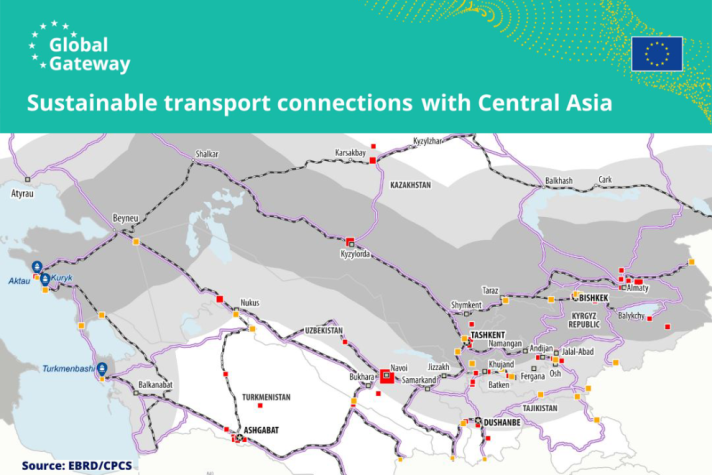Today, the European Commission published the results of the Study on Sustainable Transport Connections between Europe and Central Asia as one of the actions taken to implement the Global Gateway strategy, offering a solid basis for major potential investments in sustainable transport connections between the EU and Central Asia. The study conducted by the European Bank for Reconstruction and Development (EBRD) and funded by the EU identifies a network of the most sustainable transport connections and investment opportunities for the five Central Asian countries to maximise their sustainable economic potential by linking up better with each other – and with Europe.
Commissioner for International Partnerships, Jutta Urpilainen, says: "The study gives a strategic sense of direction to transport infrastructure planning and development in the Central Asian region. It opens up opportunities for interested public and private sector investment in key connectivity projects that fulfil strict sustainability requirements and have been identified in close consultation with the partner countries. The study is a solid basis to work together on making the Trans-Caspian corridor more efficient as soon as possible."
Commissioner for Transport, Adina Vălean, says: "This comprehensive Study has taken on significant geopolitical importance in light of Russia’s invasion of Ukraine. The coherent transport corridor approach will contribute to the competitiveness, economic attractiveness and operational efficiency of transport networks in Central Asia. The results include concrete recommendations in terms of both hard infrastructure and soft connectivity elements – if all these proposed action items and projects are implemented, the Central Trans-Caspian network could ensure a predictable transit time of 13 days. I look forward to bringing Europe and Central Asia closer together through sustainable transport links."
Alongside 33 identified and prioritised hard infrastructure investment needs across the region (related to modernisation/reconstruction of existing railways/roads, additional rail/road links, fleet expansion, port capacity expansion, rolling stock, logistics centres, warehousing, etc.), the study also proposes 7 coordinated actions on soft connectivity measures (trade facilitation, regulatory measures, digitalisation, harmonisation of tariffs, customs procedures, border controls, interoperability, market liberalisation, etc.). Recommendations include setting up a formal corridor management institution, the digitisation of transport documents, enhancing paperless cross-border trade, increased interoperability, market liberalisation and co-ordinated tariff setting. These are all specific, concrete, implementable and realistic actions that can contribute to the sustainability, competitiveness, economic attractiveness and operational efficiency of transport connections in Central Asia.
The study, whose key findings were presented by Executive Vice President Valdis Dombrovskis at the second EU-Central Asia Economic Forum on 19 May 2023 in Almaty, Kazakhstan, looks at sustainability in the widest sense, taking into account environmental, socio-economic, financial, fiscal sustainability, as well as political viability.
The study will lead to a series of detailed stakeholder consultations in the autumn of 2023 and an Investors’ Forum envisaged in early 2024 to ensure that there is also concrete follow-up on the projects identified in the study in a Team Europe approach.
Background
The study, conducted between November 2021 and June 2023,had two objectives:
- Identifying the most sustainable transport corridors connecting the five Central Asian republics (Kazakhstan, Kyrgyzstan, Tajikistan, Turkmenistan, and Uzbekistan) with the EU’s extended Trans-European Transport Network (TEN-T), following a corridor assessment based on a strict sustainability criteria where environmental, social, economic, fiscal/debt sustainability as well as political viability would be taken into account.
- Proposing key actions for corridor development in terms of both physical infrastructure (hard connectivity) and enabling environment (soft connectivity), including their prioritisation based on a coherent and sustainable transport corridor development approach.
Geographically, the study assessed existing and potential new corridors that would ensure the most sustainable transport connections between all the five Central Asian republics (Kazakhstan, Kyrgyzstan, Tajikistan, Turkmenistan, and Uzbekistan) and the EU’s Trans-European Transport Network (TEN-T), which covers the 27 EU Member States, but also the Western Balkans, Eastern Partnership countries (including the Caucasus) and Türkiye.
This was done following the assessment of the current situation of transport networks in the region, as well as consultations with stakeholders including not only the Central Asian countries themselves, but also EU Member States, private sector, relevant UN bodies, relevant international organisations and associations, International Financial Institutions, civil society organisations, interest groups, and many others.
In terms of transport modes, the focus was on land transport (rail and road) and maritime connections (Caspian and Black Seas). Interoperability with other modes of transport, legal and regulatory conditions, customs procedures, existing bilateral agreements between the various countries concerned and possible multi-modal connecting points along these corridors were fully analysed.
For More Information
Study on Sustainable Transport Connections with Central Asia
Details
- Publication date
- 30 June 2023
- Author
- Directorate-General for Mobility and Transport

